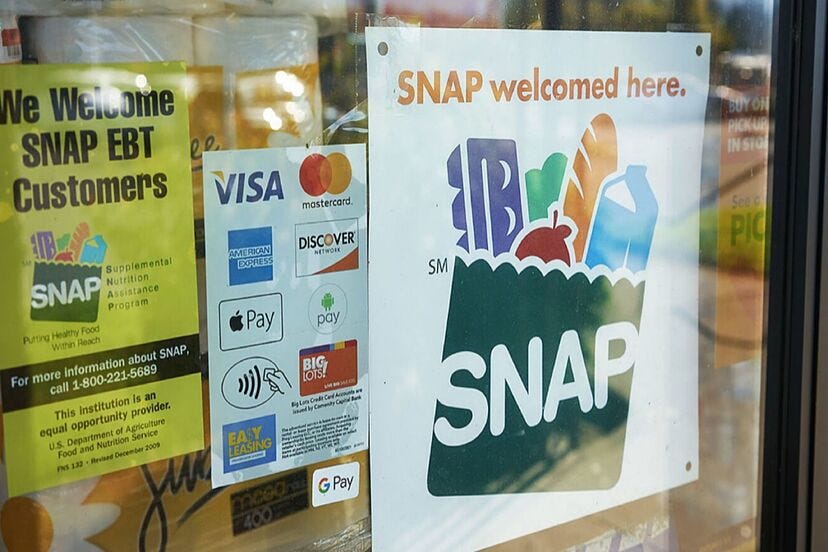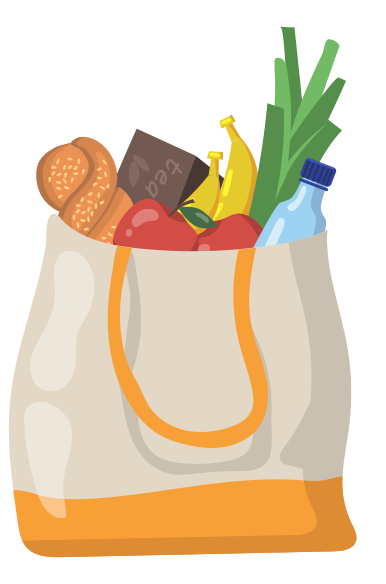I swear my credit card hates me.
Food security, the history of the modern supermarket, and some tips to make your next grocery trip cheap(-er?)
We’re at the beginning of the month, my paycheck hasn’t hit yet, and I can hear my credit card screaming as I pay for dinner and drinks, BE MORE RESPONSIBLE GIRL! My Visa deserves a break and frankly eating out all the time isn’t sustainable. Though I love treating myself and connecting with others through food, I acknowledge I sometimes must be responsible too. “Hay comida en la casa,” is what I repeat to myself under my breath with my head down low, just like my mom used to tell us when we were growing up.
I’ve found grocery shopping to be a polarizing activity you either love or hate and do out of necessity. I’ll admit some days I’m the first one, others I’m the latter. I find that the best thing I can do is set enough time and bring a list. My trusty grocery list holds me accountable and keeps me on track; even on the days I forget it inside my bag I still somehow remember most, if not all the things I wrote down. I’ve found that it’s something I enjoy doing with my husband, we divide and conquer, and since we both eat similarly and have a rotation of things we always buy, it’s a fairly quick task.
I acknowledge I am approaching this from a place of privilege; I am employed, have enough money for food, and have access to grocery stores and transportation. This isn’t the case for many Americans. According to Feeding America 34 million Americans are food insecure, of which 9 million are children. The pandemic made hardships worsen for food insecure individuals through high unemployment rates, lack of access to food, changes in food supply chains, and skyrocketing prices. 41.9 million Americans are part of the Supplemental Nutrition Assistance Program (SNAP, formerly known as food stamps), a federal program that provides monthly funds to those in need who meet program eligibility.
The average monthly SNAP benefits for a household of 1 is around $200. In 2020 due to the pandemic, Congress passed emergency allotments, or temporary financial boosts to SNAP benefits. With food prices at >25% what they were at pre-pandemic levels, the SNAP maximum benefit allowance was adjusted in 2021. Emergency allotments came to an end in February 2023, all while prices continued to rise.
The SNAP program is covered by the Farm Bill, a law that also covers farming practices, crop insurance, and more, passed every 5 years. The Farm Bill just expired this past September, which leaves the fate of nutrition programs like SNAP unclear until new legislation is passed; SNAP may be subject to unknown changes impacting the thousands of families enrolled. We could sit here and talk politics and whatnot, although it’s not today’s case, I found it worth mentioning because it helps me put things into perspective.
Most patients I work with receive SNAP benefits; I tag team with social workers to help them with program enrollment, finding food pantries, and providing culturally sensitive nutrition education that also takes into account their socioeconomic status. We get creative in session; I provide patients with skills and knowledge so they feel empowered to make healthy choices, we explore food choices together considering their health conditions and income, we make meals together, and set realistic goals. With food prices on the rise alongside low wages, inequality, and inflation, it’s more obvious that food insecurity goes beyond just access to food.
When thinking about grocery shopping I noticed how most stores are the same; they have several aisles all divided by similar categories, they have similar sections in the back such as deli and produce, and they have check-out points with grab-and-go treats in the front. So I looked up “What was the first modern supermarket in the United States?” You’ll never guess the name…Piggly Wiggly. Yup, Piggly Wiggly, a supermarket founded by Clearance Saunders in Memphis, Tennessee in 1916. Before the opening of Piggly Wiggly, supermarkets were a place where shoppers handed a list and store clerks provided all the goods, Saunders revolutionized the way we shop by having his store be the first self-service supermarket, much like how all grocery stores are today.
The Piggly Wiggly introduced shopping baskets, uniforms, price-marked items, and the supermarket franchise model. The idea of in-store marketing and strategically placing certain items at eye level is also thanks to Saunders, a model that more stores copied later on. In the 30s more supermarkets opened up, and the success of franchises rose after WWII when many mom-and-pop shops had to close as employees went off to war.
Grocery stores shifted daily living and were a big part of how society evolved. With technology evolving and bringing an even bigger shift in lifestyle, many people now opt to buy their groceries online, with a significant increase seen these past years thanks to the COVID-19 pandemic. Online grocery shopping is also a valuable option for more vulnerable populations such as the elderly and disabled, but sometimes I do it out of necessity when I can’t make it to the store, or when I only need a few key items.
We have multiple options to choose from, just look at the cereal aisle and you’ll find boxes of all shapes, sizes, crunch, and flavors. Yes, it’s great to have many options, but we also pay the price of making decision after decision, called decision fatigue. Our brains get tired and we may end up unintentionally making decisions we didn’t intend to, like adding extra stuff we don’t need to our cart. Nostalgia, taste, and branding drive our decisions when shopping. Other factors might include dietary needs, budgeting, convenience, knowledge, mood, and hunger. Avoiding grocery shopping when you are hungry or tired can help diminish the risk of decision fatigue and can help you make better choices, and stick to your budget and meal plan. Your credit card will also thank you.
And for those wondering, yes, the Piggly Wiggly still exists. There are more than 500 locations, though I have yet to visit one. And no, Saunders was never clear on why he chose that name.
Some grocery shopping and budgeting tips (from a girl who is, well, also figuring it out…)
1. Take Inventory Before You Leave
What items do you already have? What are you missing? Buying doubles can be a waste of money! Try going through your fridge, freezer, and pantry to avoid overspending and creating food waste.
2. Make a List
I told you, my trusty list keeps me in check. I like to make a list of potential meal ideas and figure out what I need based on the recipes and what I already have at home. Planning ahead can make cooking for the week and meal prepping a much smoother process.
3. Make More Meatless Meals
Plant-based protein sources are cheaper and can last longer! Consider swapping one meal a week if this idea is new for you, for example, make a grain bowl for lunch, tacos with beans for dinner, or try a tofu stir fry. Adding legumes to other dishes is also a good money-saving idea, for example, adding mashed beans or lentils to ground beef = more food, less cost.
4. Conventional vs. Organic?
If you’re trying to stay on a budget, there truly is no need for organic produce, just wash your produce once you get home. Organic produce is not nutritionally superior to conventional produce, and the amount of produce we need to eat to see a negative effect from pesticides is waaay more than what you think.
5. Think Convenience
Convenience foods are foods that are ready to eat or need little-to-no preparation. Think yogurt and string cheese, pasta sauce, and pouched lentils, and quick oats, and canned goods. Convenience foods take us out of a pinch, help save cooking time, and can be a balanced meal/snack, or a part of one. Convenience foods get a bad rep because of “processing”, but processing can make foods more shelf-stable, more nutritious, more accessible, and safer. Almost everything we eat is processed to some extent…but we’ll leave that topic for another day.
6. Think Seasonal (or frozen, that works too!)
When produce is in season it tends to be cheaper. The Florida Department of Agriculture and Consumer Services has a graphic for each month of the year of seasonal produce, check out October’s list! If you’re in another state make sure to look online for seasonal produce in your region. It’s worth mentioning that buying frozen fruits and vegetables is as good as fresh; fruits and vegetables are frozen at their peak freshness and will at times have greater nutritional value than their fresh counterparts.
7. Think Store Brands
I know, the cute little packaging gets me too sometimes, but generic or store brands do tend to be cheaper; items like canned tomatoes, milk, olive oil, and frozen fruits and vegetables are usually available in a cheaper store brand version. You can look at the ingredient list and the nutrition label to see if you’re making the right choice for you.
8. Think Unit Price
If you want to take it to the next level, look at the unit price. Similar foods are sometimes sold in different-sized packaging, how do you know if you got a good deal? It takes a little math, so I’ll leave this link for those who are interested in learning more.
9. Sign Up for Rewards
Many grocery stores have loyalty programs where you can earn cash back or get rewards while you shop; some even have their own apps where you can get exclusive deals, digital savings, or in-store QR codes for discounts. You can also look up coupons in the store, online, or in newspapers.
10. Time Your Shopping
Avoid grocery shopping when you’re hungry or hangry, as this can lead to lots of impulse buys. Try to go when you have plenty of time so you don’t rush and stress. Opt for a time when it’s less crowded, usually early in the morning or late at night; 4-6 P.M. tends to be the busiest time during the weekdays.
I’ll leave you with this little template you might find helpful, happy shopping! :)










